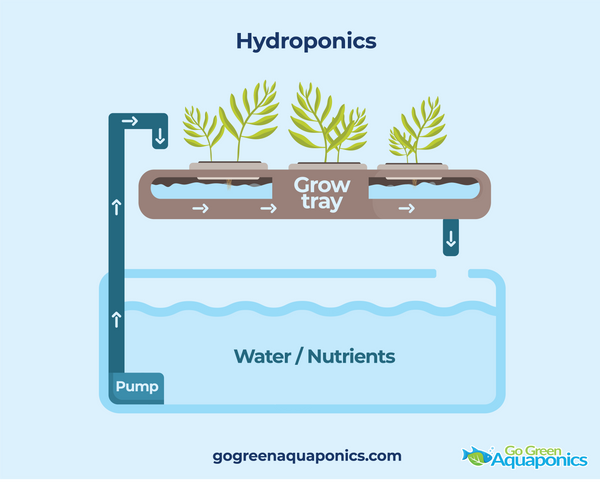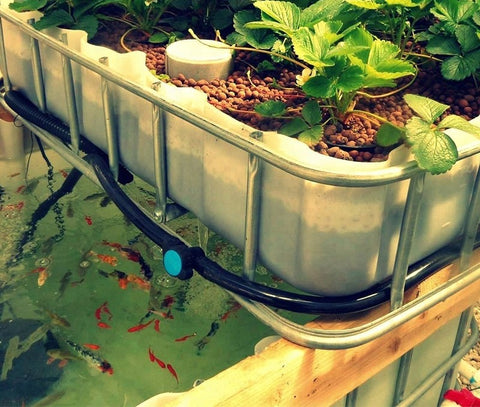Two techniques that continue to gain significant attention in the world of sustainable agriculture are aquaponics and hydroponics. This article will discuss what is the difference between hydroponics and aquaponics to help readers understand each system's fundamental principles, components, and techniques. Our primary focus is to explore the key differences that set these two innovative approaches apart. To help readers gain insights into the unique characteristics, advantages, and limitations of hydroponics and aquaponics.

What is Aquaponics?
Aquaponicsis a sustainable agricultural system that combines aquaculture and hydroponics. It is a closed-loop ecosystem where fish, plants, and beneficial bacteria work harmoniously to create a recirculating environment. Fish, like tilapia, provide the essential nutrients for plants, while the plants help filter and purify the water for the fish. It's a mutually beneficial relationship that mimics nature's cycles.
A. Components of an Aquaponics System
- Fish Tanks: The fish tanks house aquatic species, such as tilapia, catfish, or trout.
- Grow Beds: Grow beds are containers filled with a growing medium like gravel, clay pellets, or foam. This is where plants are cultivated. The water from the fish tanks is pumped into the grow beds to provide plants with the necessary nutrients, such as nitrogen, phosphorus, and potassium.
- Beneficial Bacteria: Within the grow beds and the system as a whole, beneficial bacteria play a vital role. These bacteria convert the toxic ammonia from fish waste into nitrites and then into nitrates, the primary nutrients plants absorb.
B.How Aquaponics Works
Here's a brief overview of how aquaponics operates:
- Fish produce waste, primarily ammonia, which is released into the water.
- Beneficial bacteria naturally develop in the grow beds and convert ammonia into nitrites and nitrates.
- The plants absorb these nitrates as nutrients.
- As the plants take up these nutrients, they filter and purify the water, which is then recirculated back into the fish tanks, providing clean, oxygenated water for the fish.
- This closed-loop cycle continues, benefiting both the fish and the plants.
C. Advantages of Aquaponics
- Resource Efficiency: It utilizes a fraction of the water compared to traditional soil-based farming, yielding comparable or even higher crop yields.
- Reduced Environmental Impact: Aquaponics creates a closed-loop system where water and nutrients are continuously recycled, minimizing waste and chemical usage.
- Year-round Cultivation: Like hydroponics, aquaponics can support year-round growth, making it suitable for any climate.
- Organic and Pesticide-Free: The controlled environment minimizes the need for pesticides, making it easier to produce organic crops.
D. Challenges and Limitations of Aquaponics
- Initial Setup Costs: Setting up an aquaponics system can be expensive. It involves building fish tanks grow beds, and installing pumps and aeration systems. However, long-term savings in water and fertilizer costs can offset these initial expenses.
- Maintenance and Monitoring: Aquaponics systems require consistent monitoring of water quality, fish health, and plant growth. Maintaining the balance between fish, bacteria, and plants can be challenging.
- Limited Crop Variety: Aquaponics can grow a wide range of crops, but certain plants may not thrive in this system due to specific nutrient requirements or space constraints. It's essential to choose crops that are well-suited to aquaponics.

What is Hydroponics?
Hydroponics is an agricultural method that involves cultivating plants in a soilless environment. Instead of traditional soil, hydroponics relies on nutrient-rich water solutions to give plants the essential elements they need for growth. This innovative technique allows precise control over growing conditions, optimizing plant development and crop yields.
A.Components of a Hydroponics System
- Nutrient Solution: The nutrient solution is a vital component of hydroponic systems. It consists of a carefully balanced mixture of water and essential nutrients such as nitrogen, phosphorus, potassium, calcium, and magnesium. This solution provides all the necessary elements that plants typically extract from soil.
- Growing Medium: In hydroponics, plants are typically placed in an inert, soilless growing medium such as perlite, vermiculite, coconut coir, or Rockwool. These materials support the plant's root structure while allowing for the free circulation of the nutrient solution.
- Water Reservoir: The water reservoir serves as the central hub of the hydroponic system. It holds the nutrient solution, which is then distributed to the plant roots as needed. Proper aeration and circulation of the solution are crucial to maintain oxygen levels and prevent root rot.
B.How Hydroponics Works
Here's a simplified overview of how hydroponics operates:
- Plants are placed in a growing medium.
- The nutrient solution, enriched with essential minerals, is pumped or dripped directly to the plant roots.
- Since the growing medium doesn't hold nutrients like soil, plants can absorb the nutrients readily, which accelerates growth.
- As a closed-loop system, excess nutrient solution is collected and recirculated, reducing waste.
C. Advantages of Hydroponics
- Resource Efficiency: It uses significantly less water than traditional soil-based agriculture since water is recirculated within the system.
- Faster Growth: Plants in hydroponics typically grow faster due to the constant availability of nutrients and ideal growing conditions.
- Space Efficiency: Hydroponic systems can be vertical or stacked, maximizing space utilization.
- Reduced Pest and Disease Pressure: The controlled environment minimizes exposure to pests and diseases, reducing the need for pesticides.
- Year-round Cultivation: Hydroponics allows for year-round cultivation, making it suitable for locations with harsh climates.
D. Challenges and Limitations of Hydroponics
- Reliance on Artificial Nutrients: Hydroponic systems rely on synthetic nutrient solutions, which can be expensive and raise concerns about sustainability and environmental impact.
- Vulnerability to System Failures: Hydroponic systems depend on mechanical components like pumps and timers. Failures in these components can lead to disruptions in nutrient delivery, potentially harming crops.
- Environmental Concerns: Disposal of used nutrient solutions can be problematic, as they may contain excess nutrients that can harm local ecosystems if not appropriately managed.

The Key Differences Between Aquaponics and Hydroponics
Aquaponics and hydroponics are both soilless ways of growing plants. The main difference between the two is with aquaponics, fish waste is used as nutrients for the plants. On the other hand, hydroponics used nutrient solutions mixed directly with water to grow the plants. Here are some of the most significant differences between aquaponics and hydroponics.
|
Aquaponics |
Hydroponics |
|
|
Definition |
Combines aquaculture (growing of fish) and hydroponics (growing plants without soil). |
Growing plants without soil through the use of nutrient solution mixed with water. |
|
Nutrients Used |
Fish waste |
Chemical nutrients |
|
Cost |
The initial setup costs tend to be higher due to the need for fish tanks, aquatic environment management, and fish care. Operating costs may also include fish feed and additional equipment maintenance.
|
Have lower initial setup costs, primarily involving the nutrient solution delivery system, growing medium, and basic environmental control. Operating costs focus on electricity, water, and nutrient solution expenses.
|
|
Productivity |
Higher yield than hydroponics because it offers income from fish and plants. |
Lower yield than aquaponics because the income only comes from the plants. |
|
Maintenance |
Maintaining the health of both fish and plants in aquaponics relies heavily on monitoring beneficial bacteria populations and water quality. Properly managing these factors is crucial to efficiently converting fish waste into plant nutrients. |
Demand meticulous monitoring of the nutrient solution. Growers must regularly check and adjust nutrient levels to prevent plant deficiencies or toxicities. |
|
pH |
The ideal range for pH in aquaponics is 6.8 to 7.0. Maintaining pH in the ideal range is necessary for aquaponics. |
The ideal range for hydroponics is 5.5 to 6.0. |
|
Ease of Use |
Easier to use and maintain than hydroponics. However, it is more complicated to set up because of the presence of fish, plants, and bacteria. |
Much easier to set up and control but requires more maintenance. |
What do Aquaponics and Hydroponics Have in Common?
Aquaponics and hydroponics are closely tied together and follow the same principles. There are many similarities between the two growing methods, and these are:
- Aquaponics and hydroponics are closely tied together and follow the same principles. There are many similarities between the two growing methods, and these are:
- Both are soilless growing methods of growing plants.
- Aquaponics and hydroponics rely on water to deliver nutrients to the plants.
- Both growing methods are stable and can produce higher yields than the traditional soil growing method.
- Both methods can be set up indoors or inside a greenhouse.

Choosing Between Aquaponics and Hydroponics
A.Factors to Consider When Selecting a System
- Goals and Objectives: The choice between aquaponics and hydroponics should align with your farming goals. Aquaponics may be the better choice if you aim to cultivate both fish and crops while promoting a sustainable ecosystem. Hydroponics might be more suitable if your primary objective is maximizing crop yields with precise nutrient control.
- Budget and Resources: Assess your financial resources and budget constraints. Aquaponics typically have a higher initial setup cost due to fish-related components, whereas hydroponics requires less upfront investment. Consider your ongoing operating expenses, including energy, water, and maintenance.
- Location and Available Space: The available space and environmental conditions also play a crucial role. With its fish component, aquaponics may require more space and specific environmental conditions for fish health. Hydroponic systems can be adapted to various indoor and outdoor spaces.
Conclusion
Both systems have their own advantages and disadvantages. So much of the decision on what soilless growing method to choose. It will depend on your needs, budget, knowledge, and products you want to harvest from your system. One thing to keep in mind in choosing is to research each growing system, so you’ll know what is best suited to you. Thank you for reading our article. To learn more about aquaponics, read. “The Ultimate Aquaponics Beginner’s Guide.”






Leave a comment (all fields required)